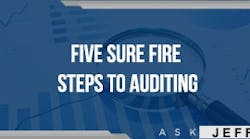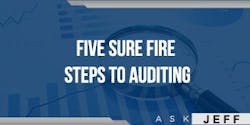In a little deviation from the typical "Ask Jeff" question-and-answer model, I wanted to share a detailed guide as an add-on to a previous blog post on sustaining changed behaviors.
How to start? We don’t have to waste a lot of time. It’s easy to leverage similar approaches from standards such as ISO 9001 and so on. In the simplest of terms, ISO 9001is a quality management standard where an organization says that it will assess and document its processes, adhere to the standard, and audit to ensure compliance with the standard. Simply put, it asks organizations to answer, "Did we do what we said we would do?" We can take that same approach in the maintenance and reliability world.
Step 1 - Define your current business processes and then develop the desired processes. Document these in the form of graphical workflows coupled with RACI or RASI matrices. In doing this, you will identify who is responsible and accountable for given tasks, who serves as support, and information needed to complete the tasks. Many organizations already have these, but their use is not enforced. Now is the time to revisit them and improve them if necessary.
Yes, I envision your eyes glazing over when I talk about this documenting process. I can hear you saying, “When am I going to find time to do that?” It is often overlooked or avoided, but it's important because it sets an expectation. These documents are part of what we call "standardized work." They represent one way of doing things. Without expectations, how can you hold people accountable? Be sure to involve in the development process the people who will be executing the processes. It’s much easier to buy into things when you helped create them.
Step 2 – Train people on the processes. You can’t expect them to meet the expectation if they don’t know what it is, right? Better yet, have those who helped create the process perform the training.
Step 3 – Determine how you will audit the behaviors. In this post, I’m going to focus on the maintenance work execution process from an audit perspective. You need to decide how you will audit, who will take part, the frequency, how you will document the audit, and finally, how you will act on the findings.
- Develop an audit template of what you will evaluate in the audit process. Find here a link to a simple sample audit from which you can adapt your template. You will need to modify the template based on your processes. The template can also be modified to include a ranking for each component to evaluate how each work order was executed to allow for a more detailed comparison. That said, if you make the auditing process too cumbersome, people will not perform the activity. Audit three completed work orders on each audit walk. In this stage, we are looking to see whether the process is working. Let me be clear: The intent is not to assign blame or define technician issues. Rather, it's to answer, "Is the process working?" If not, why isn't it?
- Avoid assigning audits to individuals. Think groups. Take the maintenance manager, the supervisor, the planner-scheduler, the storeroom clerk, the production supervisor, and the technicians who completed the work. Especially on the first audits, take the plant manager and operations manager, too. Groups allow people to learn and share. Here’s a tip: When everyone knows that people are looking at the work completed (auditing), things tend to get done the right way.
- Start weekly or every two weeks as a minimum. Remember, you are trying to change and sustain behaviors. Later, you can drop back to monthly audits, but they should be no less frequent than this.
- Take a copy of your audit template and document the findings. Look for opportunities to improve continuously. Post the findings on a visual work management board in a central location for plantwide viewing, not in the maintenance shop area. Reliability is not a maintenance thing; it’s an EVERYBODY thing.
- Take action and implement improvements. As a rule, I find that people are trying to do the right thing. You may find someone using a workaround. In some cases, the process may not have been vetted well before it was implemented. When that happens, look first at the process. Is it improper? Can it be improved? If not, then address the behaviors. If you change the process, then retrain people. Validate the process in future audits.
Step 4 – Celebrate people who are performing in the right way. This can be as simple as a handshake and a "thank you." Reinforce the right behaviors.
Step 5 – Per Deming, improve constantly and forever. The audits should be your guide. As business requirements change, modify and improve the processes.
Please share your thoughts below. How many of you have a formal audit process? Do you do it? What do you find works regarding sustaining the right behaviors? Do you have any questions?
Talk soon,
Jeff Shiver, CMRP
If you have questions in the fields of maintenance, reliability, planning and scheduling, MRO storerooms, or leadership as examples, please contact Jeff Shiver with your question(s) here.


